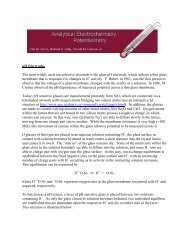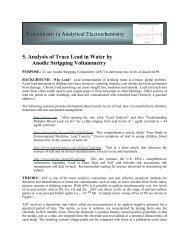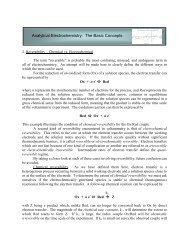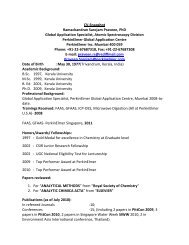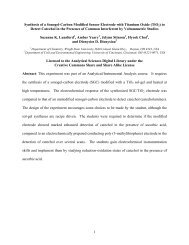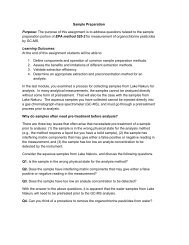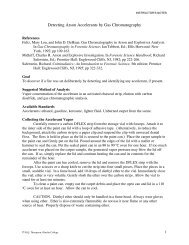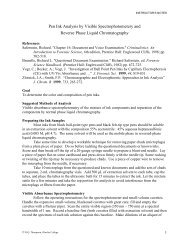Simple Activation, of Glassy Carbon Electrodes
Simple Activation, of Glassy Carbon Electrodes
Simple Activation, of Glassy Carbon Electrodes
- No tags were found...
You also want an ePaper? Increase the reach of your titles
YUMPU automatically turns print PDFs into web optimized ePapers that Google loves.
Experiments in Analytical ElectrochemistryThe Care and Feeding <strong>of</strong> <strong>Electrodes</strong>BACKGROUND: The microstructure, cleanliness and chemical composition <strong>of</strong> the electrode surfacedetermines how an electron-transfer reaction proceeds. Although a half-cell reaction <strong>of</strong> an oxidizedspecies, Ox, being reduced to species R, looks simpleOx + e- =Rthe actual process is much more complex. Let us imagine that you can sit as an observer on the electrodesurface and look out into the solution. What you would see, ignoring for the moment the composition <strong>of</strong>the electrode surface except to say that it is electrically conductive, is solvent molecules. If the solvent iswater, its molecules will appear to be moving in and out, but most will seem to be staying at the surfacewith a preferred orientation. Besides water, cations or anions <strong>of</strong> the electrolyte are present and some maybe adhering to the surface, competing with the water molecules. Assuming that you also have Ox speciesin the solution, Ox being less numerous due to its lower concentration may also be observed, albeit lessfrequently than other components, near the electrode surface. When species stick on the surface, we call itadsorption, and the extent with respect to its bulk concentration, is described by an adsorption isotherm.The amount adsorbed will go to a maximum at monolayer coverage or saturation. If you peer out at adistance beyond a few layers <strong>of</strong> water, species will be seen to be moving at random except whenelectrolysis consumes Ox and mass transfer <strong>of</strong> Ox from the bulk solution occurs to replace the depletedOx species adjacent to the electrode with R being produced. It in turn diffuses out to the bulk solutionwhere its concentration is zero. It is a very dynamic process.What happens at atomic dimensions in the first layer or so <strong>of</strong> the solution next to the surface <strong>of</strong> theelectrode depends on the value <strong>of</strong> the applied potential (with respect to the reference electrode) and on thechemical composition and structure <strong>of</strong> the surface. At some value <strong>of</strong> the applied potential, there is no netpositive (+) nor negative (-) charge on the electrode surface. The applied potential at which this occurs isreferred to as the potential <strong>of</strong> zero charge, E pzc . Water molecules will orient themselves with the negativeend <strong>of</strong> the dipole (oxygen) toward the electrode when the potential is positive <strong>of</strong> E pzc and visa-versa whenit is negative. Similarly, there will be an excess <strong>of</strong> anions to neutralize the charge when the surface hasexcess + charge and again, excess <strong>of</strong> cations when negative. This excess <strong>of</strong> cations or anions decreasesvery rapidly with distance as we move away from the electrode to the bulk solution. This region next tothe electrode where excess charge may be contained is referred to as the double layer. We can determinethe double layer charge as the applied potential is changed from one value to another by integrating thecurrent that flows. For details, the reader is referred to references [Refs. 1-3] and the experiment titled,Chronoamperometry, in this eChem Manual. To address the issue <strong>of</strong> the chemical composition andstructure <strong>of</strong> an electrode surface and how these can affect the electrode reaction will be illustrated next bydiscussing what happens at a Pt electrode.Platinum Electrode: How its chemical composition affects electrochemical reactions.Pt is a noble metal that is very stable and resistant to corrosion. Because <strong>of</strong> its stability, like Au, it is <strong>of</strong>tenused to make jewelry. As an electrode, it is used to oxidize organics or to generate hydrogen or reduce
oxygen. You can order Pt as a wire <strong>of</strong> various diameters or foil with different thicknesses. Cypress/ESAsells Pt disk electrodes encased in glass or PEEK polymer with tip diameters <strong>of</strong> 1 mm and 10 um. Thesecontain polycrystalline Pt, not single crystals, so the atoms are not arranged with a defined crystallinestructure. Often, Pt electrodes contain a small amount <strong>of</strong> rhodium to give rigidity, especially when theelectrode is a thin foil.Figure 1 shows the cyclic voltammogram <strong>of</strong> a smooth Pt electrode in 0.5 M H 2 SO 4 . Usually, initial CVsdo not show such well-defined peaks or waves as seen in this figure. After many repetitive cycles, thepeaks will begin to emerge as the surface is cleaned, and will go to a steady-state voltammogram. In thepotential region <strong>of</strong> 0.4 to 0.8 (vs. NHE), the Pt surface is "clean" and the current flows to charge thedouble layer. As the potential goes more positive, the current is attributed to the formation <strong>of</strong> adsorbedoxygen or platinum oxide. The potential indicated by "2" is the start <strong>of</strong> bulk oxygen evolution. As thepotential scan is reversed, the cathodic current is attributed to the reduction <strong>of</strong> surface platinum oxide. Ifthere is dissolved oxygen in the solution, it will be reduced in this potential region concurrently with thereduction <strong>of</strong> platinum oxide. Scanning through the double layer region, the peaks due to adsorbed H-atoms are seen, where the shape, size and number <strong>of</strong> peaks depends on the crystal faces <strong>of</strong> the Pt surface.Bulk hydrogen evolution begins at "1." These surface processes are pH dependent with the cyclicvoltammogram shifting by -60 mV per unit pH. The integrated charge under the H-atom adsorption peaksis said to be a good indicator <strong>of</strong> how many "clean" Pt atoms are on the surface and thus, a determinant <strong>of</strong>the surface area <strong>of</strong> active Pt [ref. 4]. Reference #4 is an excellent source to learn about chemisorptionprocesses at solid electrodes.Figure 1. Cyclic voltammogram for a smooth Pt electrode in 0.5 M H2SO4. The various regionsare discussed in the text. The shape, number and size <strong>of</strong> the peaks depend on the pretreatment <strong>of</strong>the electrode, solution impurities and supporting electrolyte. Reprinted with permission from A. J.Bard and L. Faulkner in Electrochemical Methods: Fundamentals and Applications, 2 nd Ed., J.Wiley & Sons. Copyright J. Wiley & Sons 2001.
Surface cleanliness is a major issue with all electrodes. Pt is unique in that the surface impurities can beremoved by repetitive scanning through a potential region where the impurities can be oxidized orremoved into solution as platinum oxide is reduced. In the double-layer region, the high surface activity<strong>of</strong> Pt, due to its atoms having unfilled d-orbitals, can be used advantageously to detect analytes eluted inliquid chromatography utilizing a technique called "pulse amperometric detection (PAD)" [ref 5]. PAD isa pretty neat idea. Analytes (e.g. aliphatic amines, carbohydrates and alcohols) that normally are notconsidered electroactive are adsorbed onto the clean Pt surface while the applied potential is held in thedouble layer region. The potential is then stepped to a value in the Pt oxide region and there is concurrentoxidation <strong>of</strong> the adsorbed species and Pt oxide formation. The difference in the current or the integratedcharge can be related to the amount <strong>of</strong> analyte, after subtraction <strong>of</strong> the background, which is obtainedfrom an experiment without the presence <strong>of</strong> the analyte in solution. The potential is then stepped to the H-atom region to clean the electrode; i.e., to reduce the Pt oxide and remove any impurities that may be onthe surface from the oxidation <strong>of</strong> the analyte. The process is then repeated to get some statistics on theprocess. The PAD analysis relies on the amount <strong>of</strong> analyte adsorbed being proportional to theconcentration in solution, and the analyte not catalytically oxidized (dehydrogenated) by clean Pt. In thelatter case, Johnson and LaCourse have developed innovative PAD procedures to accommodate thedifferent mechanisms seen with various analytes, particularly with Au electrodes [ref. 6, 7].PAD is one illustration <strong>of</strong> how the surface chemistry plays an important role and can be advantageouslyutilized for electro analytical purposes.<strong>Activation</strong> <strong>of</strong> Pt ElectrodeThere are various ways to activate a Pt electrode. Although cleanliness is important, it is nearlyimpossible to avoid impurity adsorption unless the entire process is conducted in a sealed high vacuumchamber where the surface is cleaned by ion or electron bombardment. To preserve the cleaned surface,it is necessary to transfer the electrode to a cell containing the solution in the vacuum chamber. Not aneasy task and one that requires specialized equipment and training. One method in the laboratory is torepetitively CV cycle the Pt electrode from –0.2 V to +1.0 V vs. Ag/AgCl reference electrode in 1 MH 2 SO 4 until well-defined H-adsorption waves appear. High purity water must be used for makingsolutions and for best results, the solution degassed by purging with pure N 2 or argon to remove oxygen,and maintaining a flow <strong>of</strong> the gas above the solution during experiments.Just remember, when you use solid electrodes like Pt, the surface chemistry can greatly affect what yousee for the electrochemistry <strong>of</strong> the analyte.<strong>Activation</strong> <strong>of</strong> <strong>Glassy</strong> <strong>Carbon</strong> <strong>Electrodes</strong><strong>Carbon</strong>-based electrodes are nearly ubiquitous in the laboratory today because <strong>of</strong> their availability invarious forms and shapes, and usefulness over a wide potential range. There are various compositions <strong>of</strong>carbon, ranging from highly ordered pyrolytic graphite to less ordered glassy carbon to boron dopeddiamond to carbon-paste to exquisitely small carbon nano-tubes. Rick McCreery has written acomprehensive report on carbon electrodes, their surface properties and applications [ref. 8]. The mostcommonly used carbon-based electrode in the analytical laboratory is glassy carbon (GC). It is made bypyrolyzing a carbon polymer, under carefully controlled conditions, to a high temperature like 2000 o C.An intertwining ribbon-like material results with retention <strong>of</strong> high conductivity, hardness and inertness.The electrochemistry is affected greatly by its surface chemistry <strong>of</strong> carbon-oxygen functionalities and itscleanliness; i.e., absence <strong>of</strong> adsorbed impurities. This latter has been shown by McCreery and coworkerswho cleaned and stored GC in solutions containing highly adsorbing carbon particles that preferentiallyremoved impurities [ref. 9].
We will focus on GC and discuss methods <strong>of</strong> surface activation and maintenance <strong>of</strong> surface cleanliness.For analytical purposes, Cypress/ESA <strong>of</strong>fers GC disk electrodes <strong>of</strong> 3 mm diameter encased in glass or 10um and 1 mm disks encased in PEEK polymer.The most common method <strong>of</strong> activation is to polish the GC surface with micro-sized abrasives. Suchtreatment exposes fresh new surface. The maintenance <strong>of</strong> clean conditions during such polishing iscritical. For instance, polishing on some types <strong>of</strong> abrasive containing pads can deactivate the surface [ref.10]. After polishing, sonication is <strong>of</strong>ten required to remove carbon particles and remains <strong>of</strong> polishingmaterial. These steps may be time consuming and repeated sonication may eventually destroy theelectrode by compromising the seal between the carbon and the outer cladding material (e.g., glass orPEEK). Use <strong>of</strong> large agglomerated particles for polishing may leave large surface scratches andindentations. The best activation procedure may be vacuum heat treatment (VHT) [ref.11] althoughpolishing with alumina in cyclohexane may yield comparable active GC electrodes [ref. 9]. An interestingfeature about VHT and the use <strong>of</strong> an organic solvent for polishing, are the absence or low oxygencontainingfunctionalities on the carbon surface. Chen and McCreery [ref. 12] has nicely addressed howand when such functionalities affect electron transfer processes.In this TechNote a simple method is described on how to activate a Cypress System glassy carbon (GC)electrodes that produces a smooth surface with a high degree <strong>of</strong> activation. In addition, we demonstrate amethod to keep the electrodes active during storage or between experiments to minimize need forrepolishing.ProcedurePolishing on smooth ground glass plates allows the condition <strong>of</strong> the polishing material to be tightlycontrolled for optimum cleanliness. In addition, the use <strong>of</strong> deagglomerated alumina <strong>of</strong> small particle size(0.05 µm) allows for a more scratch free active electrode surface. The use <strong>of</strong> particles <strong>of</strong> even smaller size(0.007 µm fumed silica) should enhance the smoothness and activity. If this does not activate the surface,re-polishing with larger particle size abrasive, such as 0.25 :m diamond, followed by 0.05 :m alumina or0.007 :m silica.Materials* 1 mm diameter (or larger) GC disk electrode• Ag/AgCl reference electrode• NANOpure TM deionized water• Baikalox agglomerate free alumina, 0.05 µm particle size (Baikowski International, Charlotte,NC) or Buehler 0.05 μm alumina• Fumed Silica 0.007 µm particle size (Sigma, St. Louis, MO)• Smooth ground glass plate (necessary to prevent scratches during polishing)How to polish your electrodes: The degree <strong>of</strong> activation <strong>of</strong> a GC disk electrode can be evaluated bylooking at the difference in the peak potential for the redox couple <strong>of</strong> ferri/Ferrocyanide, which isexpected to be close to 60 mV [9]. First, use a slurry <strong>of</strong> the 0.05 µm alumina to polish the electrode. Youcan add several scoops <strong>of</strong> alumina to a small wash bottle <strong>of</strong> high purity water, like Nanopure TM , and squirtit on a clean ground glass plate. For optimum cleanliness it is wise to use gloves when handling theelectrodes. This precaution is necessary so that skin oils do not get onto the electrode. Polish with lightpressure following a figure 8 pattern for approximately 30 seconds. The electrode should then beimmediately rinsed with water. It is suggested that the stream <strong>of</strong> water be directed against the surface <strong>of</strong>the electrode. Only high purity water is used throughout the activation process. In order to remove excesswater, touch the outer edge <strong>of</strong> the electrode with a s<strong>of</strong>t tissue paper like Kimwipe TM .
Now check the activation <strong>of</strong> the electrode in a solution 1 mM ferrocyanide in 1 M KCl. Be sure to degassall solutions with high purity nitrogen or argon before running the experiment. A typical result for anelectrode scanned at 100 mV/s is shown in Figure 2. For this electrode E p = 67 mV is very close to theexpected result.It is recommended that any further polishing <strong>of</strong> the electrode be done in a slurry <strong>of</strong> 0.007 µm fumedsilica. Thoroughly wash the polishing plate with water, dry with a Kimwipe TM and add a small amount <strong>of</strong>silica onto the polishing plate. Add a small amount <strong>of</strong> water to make a slurry. The silica should be visiblywhite on the plate. The electrode can be polished for 30 seconds in a figure 8 pattern, cleaned with purewater and then the outer edge <strong>of</strong> the electrode barrel be touched with Kimwipe TM to remove excess water.If your electrode does not produce satisfactory results, repeat the process.How to keep your electrodes activeGC electrodes can retain much <strong>of</strong> their activity by storing them in a solution <strong>of</strong> alumina or silica. To dothis, add 6 or 7 scoops <strong>of</strong> either alumina or silica to about 25 ml <strong>of</strong> deionized water and stir the solutionwith the electrode in it. Essentially, the electrode is being continuously polished. When you are ready touse the electrode again, rinse it with a stream <strong>of</strong> pure deionized water and it is ready to go. The CV datafor ferrocyanide oxidation, as a result <strong>of</strong> storing GC in alumina and silica, are tabulated in Table 1 andCVs are shown in Figures 3 and 4, respectively. <strong>Electrodes</strong> stored overnight in alumina or silicamaintained a much higher degree <strong>of</strong> activation than when left exposed to air.Table 1: Results <strong>of</strong> storing GC electrode in Solutions <strong>of</strong> Alumina or Fumed SilicaStored in AluminaEp, mVa) Polished with alumina 72b) Stored overnight in stirred alumina 103c) Exposed to lab air for 4 hrs 144Stored in Silica∆Ep, mVa) Polished with Silica 75b) Stored overnight in stirred silica 123c) Exposed to lab air for 4 hrs 195
Figure 2Figure 2. Cyclic voltammogram <strong>of</strong> 1 mM ferrocyanide in 1 M KCl with a freshlypolished glassy carbon electrode.
Figure 3Figure 3. CV <strong>of</strong> 1 mM ferrocyanide in 1 M KCl a) with a freshly polished GC,b) after storage overnight in alumina, and c) after exposure to air for 4 hours.
Figure 4Figure 4. CV <strong>of</strong> 1 mM ferrocyanide in 1 M KCl with a) freshly polished GC, b) storedovernight in silica, and c) after exposure to lab air for 4 hours.ConclusionsA simple, quick and inexpensive method for pretreating GC disk electrodes without use <strong>of</strong> sonication hasbeen demonstrated. The resulting electrodes have nearly reversible appearing CVs with the differencebetween the peak potentials near the theoretical value <strong>of</strong> 60 mV. In fact, this technique gives comparableresults to more time consuming and complex techniques requiring multiple polishing and sonication (Ep= 67.7 mV and 121 mV), or vacuum heat treatment ( Ep= 64.5 mV and 64 mV) [Refs. 10, 11]. Inaddition, a method has been described for retaining electrode activity for several hours (at least overnight)without polishing.We are grateful to Dr. David J. Weiss (Department <strong>of</strong> Chemistry, The University <strong>of</strong> Colorado atColorado Springs, 1420 Austin Bluff Pkwy, SB-1, Colorado Springs, CO 80918) for his contributions tothis TechNote.
References1. J. Bard, L. R. Faulkner, Electrochemical Methods: Fundamentals and Applications, 2nd Edition,John Wiley & Sons, Inc., 2001, Ch. 1.2. P.Delahay, Double Layer and Electrode Kinetics, John Wiley & Sons, Inc., 1965, Pgs. 21-31(read to understand Epzc that was determined precisely with a Hg electrode).3. Wm. R. LaCourse, Pulsed Electrochemical Detection, John Wiley & Sons, Inc., 1997, Pgs. 34-47(nice discussion <strong>of</strong> electrode interface structure and double-layer fundamentals)4. R. Woods, Chemisorption at <strong>Electrodes</strong> in Electroanalytical Chemistry, Ch. 1 <strong>of</strong> Vol. 9, edited byA. J. Bard, Publisher Marcel Dekker, Inc., 1976 (a source for a comprehensive discussion <strong>of</strong>adsorption at solid electrodes).5. See Ch. 4 in reference #3.6. D. C. Johnson, Wm. R. LaCourse, Pulsed electrochemical detection at noble metal electrodes inliquid chromatography, Electroanal. Chem., 4, 367-380 (1992).7. D. C. Johnson, Wm. R. LaCourse, Liquid chromatography with pulsed electrochemical detectionat gold and platinum electrodes, Anal. Chem., 62, 589A-597A (1990).8. R. L. McCreery in Electrochemical Properties <strong>of</strong> <strong>Carbon</strong> Surfaces, Interfacial Chemistry, A.Wiechowski Editor, Dekker, N.Y., 1999, Ch. 35, pp. 631-647.9. S. Ranganathan, T-C Kuo, R. L. McCreery, Facile Preparation <strong>of</strong> Active <strong>Glassy</strong> <strong>Carbon</strong><strong>Electrodes</strong> with Activated <strong>Carbon</strong> and Organic Solvents, Anal. Chem., 1999, 71, 3574-3580.10. D. H. Weisshaar, T. Kuwana, Considerations for polishing glassy carbon to a scratch-free finish,Anal. Chem., 1985, 57, 378-379.11. D. T. Fagan, I-F Hu, T. Kuwana, Anal. Chem., Vacuum heat-treatment for activation <strong>of</strong> glassycarbon electrodes, 1985, 57, 2759-2763.12. P. Chen, R. L. McCreery, Anal. Chem., Control <strong>of</strong> Electron Transfer Kinetics at <strong>Glassy</strong> <strong>Carbon</strong><strong>Electrodes</strong> by Specific Surface Modification, 1996, 68, 3958-3965.



